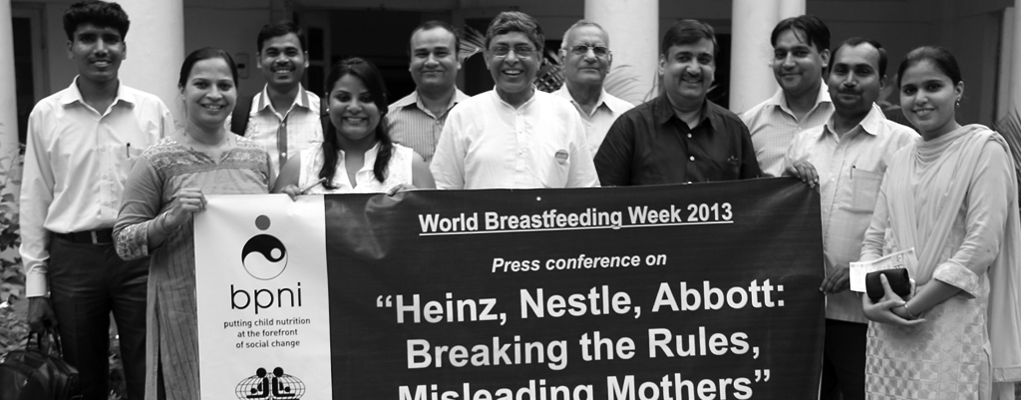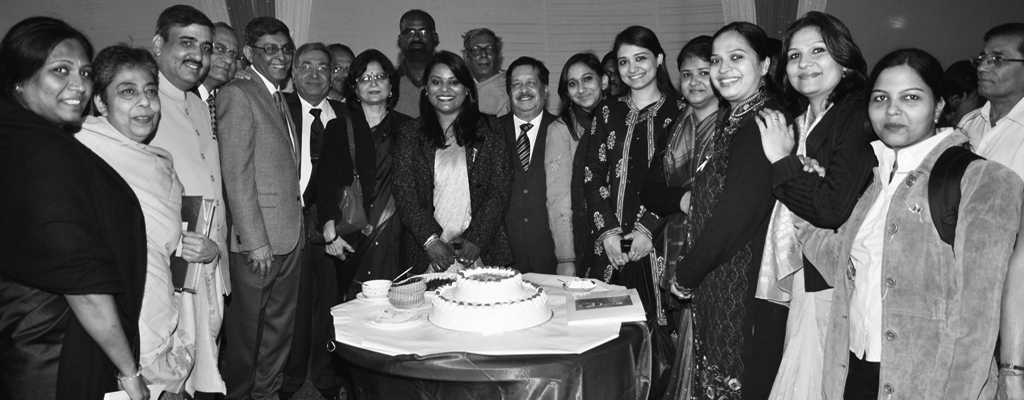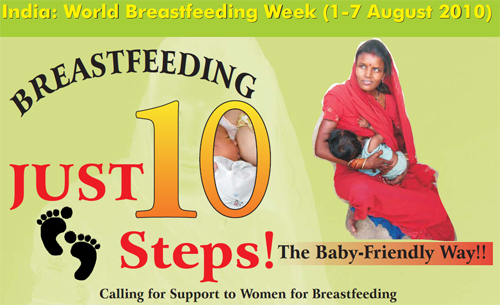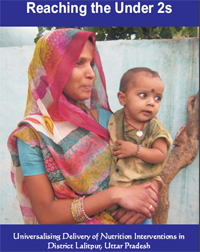|
Every year the first week of August is celebrated as ‘World Breastfeeding Week (WBW). The objective is to focus attention on some important aspect of protection, promotion and support of breastfeeding. This year the theme is ‘Breastfeeding – Just 10 Steps! The Baby Friendly Way’.
The objectives for this year are:
-
To increase attention to the contribution of the Ten Steps to exclusive breastfeeding.
-
To revitalize activities within health systems, and among healthcare providers and communities to support women to achieve their breastfeeding intentions.
-
To inform people everywhere that protection, promotion and support of breastfeeding is a mother’s right, a child’s right, and a human right.
-
To enable women and all who care about human rights to fight for health care systems which support breastfeeding.
-
To ensure that health workers who care for mothers and babies are adequately trained to counsel and support them in optimal infant feeding
A joint WHO/UNICEF statement in 19891 laid down ten essential tasks for every institution providing maternity services and care for the newborns and infants. The ‘Ten Steps were as follows.
-
Have a written breastfeeding policy that is communicated to all health care staff.
-
Train all health care staff in the skills necessary to implement this policy.
-
Inform all pregnant women about the benefits and management of breastfeeding.
-
Help mothers initiate breastfeeding within a half hour after birth.
-
Show mothers how to breastfeed and how to maintain lactation even if they are separated from their infants.
-
Give newborn infants no feed or drink other than breast milk unless medically indicated.
-
Practice rooming-in to allow mothers and infants to stay together 24 hours a day.
-
Encourage breastfeeding on demand.
-
Give no artificial teats or pacifiers (also called dummies or soothers) to breast feeding infants.
-
Foster the establishment of breastfeeding support group and refer mothers to them on discharge from hospital.
A meeting of the WHO/UNICEF and policy makers of 32 nations on”Breastfeeding in the 1990: A Global Initiative” met at Spedale degli Innocenti, Florence (Italy) on July 31 and August 1. The declaration urged all governments to take measures to promote, protect and support exclusive breastfeeding for first 4-6 months and that every facility providing maternity services practices the “Ten Steps”.
On 29-30 September 1990 the largest gathering of world leaders in history assembled at the United Nations to attend the World Summit for Children. Led by 71 heads of State Governments and 88 other senior officials, mostly at the ministerial level, the World Summit adopted a Declaration on the Survival, Protection and Development of Children and a Plan of Action for implementing the Declaration in the 1990s. The commitments included promotion of responsible planning of family size, child spacing, breastfeeding and safe motherhood.
In November 1991, UNICEF prepared the draft summary sheets for “Baby Friendly” Hospital Assessment. At the National Conference of the Indian Academy of Pediatrics at Nagpur (January 1992) Dr. Jon Rohde of the UNICEF India Country Office, spelled out the plan for ‘Baby Friendly Hospital Initiative (BFHI) in an informal meeting with some senior members of the Breastfeeding Promotion Network of India (BPNI). Maternity homes which followed the ten steps were to be recognized as ‘Baby Friendly’ and given a certificate and a plaque to that effect. It was hoped that “Thousands of hospitals throughout the world could have a plaque by the front entrance designating them as ‘baby friendly’--” 2
Later, the National Task Force was established involving various organizations like Medical Association (IMA), Academy of Pediatrics (IAP), Federation of Obstetricians and Gynecologists of India (FOGSI), Trained Nurses Association (TNAI), BPNI and other social agencies like VHAI, ACASH , UNICEF etc. A National Implementation Committee comprised of representatives from IMA, IAP, FOGSI and TNAI was formed and a team of trainers and assessors was selected. The certificates were issued jointly by the National Task Force for BFHI and the Department of Family Welfare of the Ministry of Health and Family Welfare of the Government of India.
There was a great enthusiasm to begin with. In 1995, Dr. Jon Rohde declared Cochin as a ‘Baby Friendly’ city as more than 80% of the maternity homes in that city were assessed to be baby-friendly. Unfortunately there were long delays in organizing and carrying out the assessments and giving the certificates. The enthusiasm waned and in less than a decade, the movement almost came to a standstill at the national level although some States formed their own committees and continued to assess and certify the maternity homes within their States.
The World Alliance for Breastfeeding Action (WABA) observes that by this 20th anniversary of the Innocenti Declaration, more than 20,000 maternities in the world (about 28% of all maternities) have fully implemented the Ten Steps and have been certified by the Baby-friendly Hospital Initiative (BFHI). However WABA also has observed reduced BFHI programming worldwide, inadequate training, and weakened compliance with the Ten Steps in accredited maternities.
Now that this year’s theme of the World Breastfeeding Week revolves round the ‘Ten Steps’ it is likely that the interest in the BFHI will be rekindled. We must learn from the ‘history’ and be aware of our lapses, for one who does not remember the history is condemned to repeat it. In my opinion, we lacked the enthusiasm and facilities to train all health providers and the expectant and lactating mothers in basic skill of breastfeeding and lactation management. It is also important to ensure that the machinery for assessment and certification of hospitals is well lubricated to have smooth and fast functioning.
Implementation of the ‘Ten Steps’ is a matter of rational evidence-based management and is expected from all those who manage pregnancy and child birth. ‘Reward and punishment’ is a method for behavior modification. Recognition with a certificate and a plaque is a ‘reward’ for the rational behavior though there is no punishment of the non-compliers.
BFHI, if rejuvenated and implemented with full vigor and enthusiasm, will certainly rationalize the practice in many maternity homes. The certificate was issued for life-time but there was no guarantee that the rational practices will continue perpetually. Indeed, as observed by WABA, weakening of the compliance of the accredited maternity homes has been frequently observed and there is need to have a provision of recertification every 3-5 years.
The BFHI covered only the maternity homes with more than 250 deliveries during one year- leaving a large number of small maternity homes out of its net. Moreover, about 60% deliveries are non-institutional3. There has to be a way to ensure that all those who treat and manage a neonate and the infant (obstetricians, neonatologists, pediatricians, family physicians, nurses and heath visitors) are trained in the basic skills of breastfeeding and lactation management and in the skills of communication.
Training in breastfeeding and lactation management must be a part of undergraduate medical education and of the nurses and the aanganwadi workers. Pre-conference workshops, short and long training courses need to be arranged frequently. But the activity cannot be restricted to the heath providers only. Mothers and the decision makers in the family as well as well as the social and political leaders and administrators need to be reached’
Three of the ‘Ten Steps’ viz. 1st, 2nd and 10th are the responsibility of the hospital administration. The other steps must be taken by the health providers and that is irrespective of the hospital or community setting. The following should be routinely carried out by the health provider (whatever the level – consultant, nurse or aanganwadi worker).
A. During antenatal visits: Discuss with the mother -
-
Advantages of breastfeeding and disadvantages of feeding non-human milk Importance of early initiation of breastfeeding and of colostrum
-
Proper position of breastfeeding especially giving the areola and not only the nipple Importance of demand feeding
Anything else that the mother wants to know
B. After Birth:
-
Keep the baby with the mother
-
Encourage the mother to feed the baby as early as possible
-
Ensure that no pre-lacteal feed is given
-
Teach the mother how to express breastmilk
C. At Discharge:
-
Counsel the mother for exclusive breastfeeding for 6 months and continuing thereafter into the second year while starting complementary feeding in the 7th month.
-
Give the date for follow-up visit
-
Give the name of the doctor/lactation expert whom she could contact in case of any difficulty in breastfeeding.
Arun Phatak
09.06.2010
References
1. WHO/UNICEF . Protecting, Promoting and Supporting Breastfeeding: The Special Role of Maternity Services. WHO. Geneva 1989 pp.IV
2. UNICEF. The State of World’s Children 1992. Oxford University Press. Newyork, pp 24.
3. Ministry of Health and Family Welfare, Government of India. National Family Health Survey (NFHS-3) 2005-06. Vol.I. Mumbai 2007. pp. 208.
|




